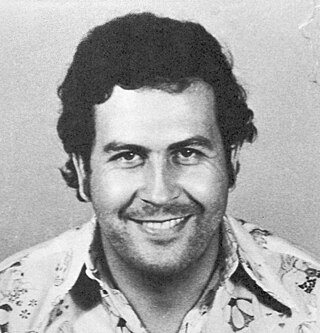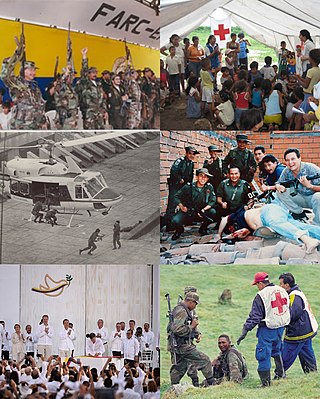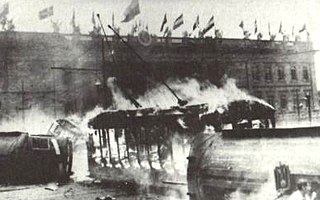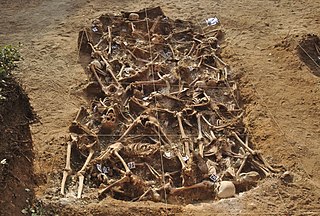Related Research Articles
The history of Colombia includes its settlement by indigenous peoples and the establishment of agrarian societies, notably the Muisca Confederation, Quimbaya Civilization, and Tairona Chiefdoms. The Spanish arrived in 1499 and initiated a period of annexation and colonization, ultimately creating the Viceroyalty of New Granada, with its capital at Bogotá. Independence from Spain was won in 1819, but by 1830 the resulting "Gran Colombia" Federation was dissolved. What is now Colombia and Panama emerged as the Republic of New Granada. The new nation experimented with federalism as the Granadine Confederation (1858) and then the United States of Colombia (1863) before the Republic of Colombia was finally declared in 1886. A period of constant political violence ensued, and Panama seceded in 1903. Since the 1960s, the country has suffered from an asymmetric low-intensity armed conflict which escalated in the 1990s but decreased from 2005 onward. The legacy of Colombia's history has resulted in a rich cultural heritage, and Colombia's geographic and climatic variations have contributed to the development of strong regional identities.

The Revolutionary Armed Forces of Colombia – People's Army is a Marxist–Leninist guerrilla group involved in the continuing Colombian conflict starting in 1964. The FARC-EP was officially founded in 1966 from peasant self-defense groups formed from 1948 during the "Violencia" as a peasant force promoting a political line of agrarianism and anti-imperialism. They are known to employ a variety of military tactics, in addition to more unconventional methods, including terrorism.

Pablo Emilio Escobar Gaviria was a Colombian drug lord, narcoterrorist, and politician who was the founder and sole leader of the Medellín Cartel. Dubbed "the king of cocaine", Escobar was one of the wealthiest criminals in history, having amassed an estimated net worth of US$30 billion by the time of his death—equivalent to $70 billion as of 2022—while his drug cartel monopolized the cocaine trade into the United States in the 1980s and early 1990s.

César Augusto Gaviria Trujillo is a Colombian economist and politician who served as the President of Colombia from 1990 to 1994, Secretary General of the Organization of American States from 1994 to 2004 and National Director of the Colombian Liberal Party from 2005 to 2009. During his tenure as president, he summoned the Constituent Assembly of Colombia that enacted the Constitution of 1991.

The Medellín Cartel was a powerful and highly organized Colombian drug cartel and terrorist organization originating in the city of Medellín, Colombia, that was founded and led by Pablo Escobar. It is often considered to be the first major "drug cartel" and was referred to as such due to the organization's upper echelons and overall power-structure being built on a partnership between multiple Colombian traffickers operating alongside Escobar. Other members included Jorge Luis Ochoa Vásquez, Fabio Ochoa Vásquez, Juan David Ochoa Vásquez, José Gonzalo Rodríguez Gacha, and Carlos Lehder. Escobar's main partner in the organization was his cousin Gustavo Gaviria, who handled much of the cartel's shipping arrangements and the more general and detailed logistical aspects of the cocaine trafficking routes and international smuggling networks, which were supplying at least 80% of the world's cocaine during its peak.

Luis Carlos Restrepo Ramírez is a Colombian psychiatrist and philosopher, who served as the 5th High Commissioner for Peace of Colombia from August 2002 to March 2009.

Luis Carlos Galán Sarmiento was a Colombian liberal politician and journalist who ran for the Presidency of Colombia on two occasions, the first time for the political movement New Liberalism that he founded in 1979. The movement was an offspring of the mainstream Colombian Liberal Party, and with mediation of former Liberal president Julio César Turbay Ayala, Galán returned to the Liberal party in 1989 and sought the nomination for the 1990 presidential election, but was assassinated before the vote took place.

The Colombian conflict began on May 27, 1964, and is a low-intensity asymmetric war between the government of Colombia, far-right paramilitary groups and crime syndicates, and far-left guerrilla groups, fighting each other to increase their influence in Colombian territory. Some of the most important international contributors to the Colombian conflict include multinational corporations, the United States, Cuba, and the drug trafficking industry.

Amado Carrillo Fuentes was a Mexican drug lord. He seized control of the Juárez Cartel after assassinating his boss Rafael Aguilar Guajardo. Amado Carrillo became known as "El Señor de Los Cielos", because of the large fleet of jets he used to transport drugs. He was also known for laundering money via Colombia, to finance this fleet.
Right-wing paramilitary groups in Colombia are paramilitary groups acting in opposition to revolutionary Marxist–Leninist guerrilla forces and their allies among the civilian population. These right-wing paramilitary groups control a large majority of the illegal drug trade of cocaine and other substances. The Colombian National Centre for Historical Memory has estimated that between 1981 and 2012 paramilitary groups have caused 38.4% of the civilian deaths, while the Guerillas are responsible for 16.8%, 10.1% by the Colombian Security Forces and 27.7% by non-identified armed groups, although the chief prosecutor of the ICC would contradict these numbers.

La Violencia was a ten-year civil war in Colombia from 1948 to 1958, between the Colombian Conservative Party and the Colombian Liberal Party, fought mainly in the countryside.

Diego Fernando Murillo Bejarano, also known as Don Berna or Adolfo Paz, is a former leader of the United Self-Defense Forces of Colombia paramilitary group, as well as the leader of The Office of Envigado cartel.

In the history of Spain, the White Terror describes the political repression, including executions and rapes, which were carried out by the Nationalist faction during the Spanish Civil War (1936–1939), as well as during the following years of the regime of General Francisco Franco. In the 1936–1945 period, Francoist Spain had many officially designated enemies: loyalists to the Second Spanish Republic (1931–1939), liberals, socialists of different stripes, Protestants, intellectuals, homosexual people, Freemasons, Jews, immigrants, Basque, Catalan, Andalusian, and Galician nationalists.
Juan Manuel Echavarria Olano is a present-day Latin American artist from Colombia. Born in 1947 in Medellín, Colombia and now resides in Bogotá, Colombia and New York City.
The depiction of Colombia in popular culture, especially the portrayal of Colombian people in film and fiction, has been asserted by Colombian organizations and government to be largely negative and has raised concerns that it reinforces, or even engenders, societal prejudice and discrimination due to association with narco-trafficking, terrorism, illegal immigration and other criminal elements, poverty and welfare. The Colombian government-funded Colombia is Passion advertisement campaign as an attempt to improve Colombia's image abroad, with mixed results hoping for more positive views on Colombia.
Colombia has a high crime rate due to being a center for the cultivation and trafficking of cocaine. The Colombian conflict began in the mid-1960s and is a low-intensity conflict between Colombian governments, paramilitary groups, crime syndicates, and left-wing guerrillas such as the Revolutionary Armed Forces of Colombia (FARC), and the National Liberation Army (ELN), fighting each other to increase their influence in Colombian territory. Two of the most important international actors that have contributed to the Colombian conflict are multinational companies and the United States.
Ignacio Gómez is a Colombian journalist known for his high-risk reporting on organized crime, corruption, and paramilitary groups. In 2000, he received the "Special Award for Human Rights Journalism Under Threat" Amnesty Media Award. In 2002, he was awarded the International Press Freedom Award of the Committee to Protect Journalists.

Escobar: El Patrón del Mal is a 2012 Colombian telenovela produced and broadcast on Caracol TV, based on a true story about the life of Pablo Escobar – the notorious druglord. It is available only in Spanish. There is a version available with English dubbed, as well as a version dubbed in Hindi on the ZEE5 app. It also aired in Arabic dub on Lana TV. It is also available in version dubbed in Turkish on Netflix.

The Colombian peace agreement referendum was held on 2 October 2016, aiming to ratify the final agreement on the termination of the Colombian conflict between the Colombian government and the FARC guerillas. It failed, with 50.2% voting against it and 49.8% voting in favor. Approval of the referendum was taken for granted in Colombia prior to the vote based on opinion polls. However, the 'No' option ended up winning by a narrow margin.

The Memorial to Victims of Violence in Mexico, also referred to as the State Violence Victims Memorial, is a memorial in Chapultepec, Mexico City. Its construction started in 2012 during the presidency of Felipe Calderón and it was opened on 5 April 2013, during Enrique Peña Nieto's administration. As its name suggests, it was created to pay tribute to those who had been victims of violence in the nation.
References
- ↑ Fichtl, Eric (August 2005). "Contested Country: An Examination of Current Propaganda Techniques in the Colombian Civil War". Colombia Journal. Archived from the original on 12 March 2008. Retrieved 15 July 2009.
- ↑ Uribe, María Victoria (Winter 2004). "Dismembering and Expelling: Semantics of Political Terror in Colombia". Public Culture . 16 (1): 79–95. doi:10.1215/08992363-16-1-79. S2CID 144443292 .
- ↑ Jiménez Becerra, Absalón (2013). "El periodo de la violencia en Colombia y el uso de las imágenes del terror, 1948-1965" [The role of the image, the imaginary and political memory in Colombia](PDF). Revista de Antropología Experimental (in Spanish) (11): 151–165. ISSN 1578-4282. Archived from the original (PDF) on 3 June 2022. Retrieved 27 July 2024.
- ↑ Bowden, Mark (2001). "Chapter 1". Killing Pablo . New York: Atlantic Monthly Press. ISBN 978-0-87113-783-8 . Retrieved 15 July 2009.
- ↑ Koerner, Brendan I. (17 November 2009). "The Colombian Necktie Half-Truth". Microkhan. Retrieved 15 March 2021.
- ↑ Iovine, Anna Rose (16 March 2016). "Faye Resnick Videos Addressing The Drug Cartel Theory On 'The People V. O.J. Simpson' Shows Just How Complicated The Case Was". Romper. Retrieved 30 March 2021.